Daf: three electric trucks trialled
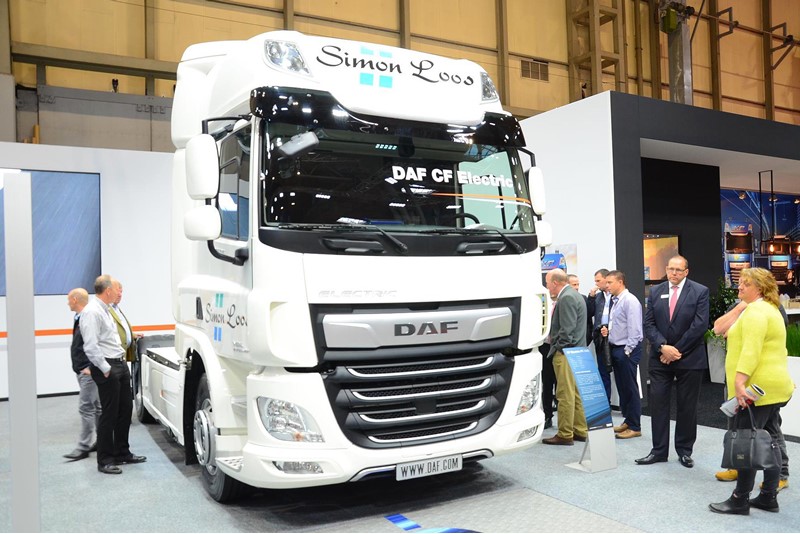
Daf is trialling three electric truck options in Europe as it starts to assess reliability, real-world range, ease of use and driver acceptability.
Further pilots are planned, including in the UK where the company has a shortlist of candidates to take on trucks for a year-long project. Most are expected to be in and around London, where electric trucks “make most sense”, according to Daf UK managing director Robin Easton.
Daf is partnering VDL on the technology for the CF electric truck, Cummins for the electric LF and ZF Tech for the hybrid CF, which has up to 20 miles of electric-only range.
The electric CF has a full-load range of up to 60 miles, while the LF has a modular pack enabling up to 125 miles. Its range can be adapted to the fleet’s needs; fewer battery packs will reduce the price.
Fast-charging at a 300kW station takes the CF from empty to full in just 30 minutes, making it ideal for delivery operations which can recharge while unloading.
“It will enable 24-hour operation,” said Easton.
Electric CF trials will continue throughout 2019, with operators able to place orders towards the end of the year for delivery in 2020.
“We have had a lot of interest, particularly from supermarket operations,” said Easton. “We’ve also had a lot of enquiries about the LF – fleets want it now. Demand is being driven by regulations so I don’t see big volume until 2025.”
The impact on payload for the electric LF is “not material”, he added. The penalty is around 1,500kg on an 18-tonne truck.
Pricing will be around three times that of an equivalent diesel, resulting in a longer payback period. Easton doesn’t expect price parity “until the next decade”.
Daf is also pushing the benefits of hydro-treated vegetable oil (HVO) fuels, which all its trucks can now use. Availability remains an issue, although more vendors are coming to market.
It has a slight premium per litre over diesel, but Daf claims a well-to-wheel reduction in CO2 emissions of up to 90%.
“It’s an easy opportunity for customers to reduce their carbon footprint,” says Easton. “We are considering filling every truck that comes from our plant with HVO to get the message out there.”
HVO and diesel are interchangeable and there is no impact on servicing schedules or warranty.
Fiat Professional: petrol demand rises for van range

Fiat Professional has seen a major shift in its engine mix, with petrol increasing from 10% of sales to 60% over the past couple of years.
Many of its petrol vans, typically smaller panel vans such as Fiorino, are destined for city operators, especially small businesses.
The company, which was planning for a drop in market registrations this year, has enjoyed a strong first quarter, with a corporate demand particularly high.
“In London, we have seen movement from Euro 5 to Euro 6 as fleets look to comply with the ultra-low emission zone,” said Richard Chamberlain (pictured), FCA Professional head of brand.
Fiat is also planning its production cycles in the build up to the new WLTP regime, which comes in for all vans from September.
“It’s a challenge; cars were straightforward but with vans we have conversions so we have to build those into the customer’s schedules,” Chamberlain said. “But we will have all homologations in place by the time we get to production in June.”
Changes to the line-up enforced by the new WLTP regime will see Fiat end production of the 2.0-litre diesel Ducato large panel van. The 2.3-litre will remain, but with uprated power and improved fuel efficiency, plus a new 180PS version.
In production from June, Fiat is also taking the opportunity to make tweaks to the interior, such as a new infotainment system.
Chamberlain expects the rest of the year to remain strong, with Fiat’s main focus on its existing customers and core products.
He is also looking further ahead to the company’s first electric vans. A full electric Ducato is in final testing with a number of customers across Europe; a launch date is “not far away”, according to Chamberlain.
Although there are no firm details, he claims the range will be a step up from the distances offered by the current crop of EVs.
“The market is gathering pace and we will be at the forefront as it evolves,” he adds.
Isuzu: New fleet deals drive growth at Isuzu
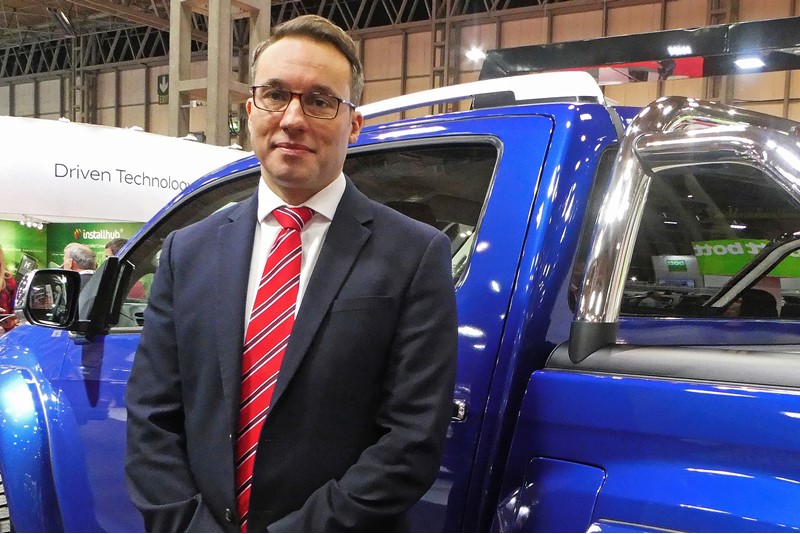
Isuzu is predicting a growth in registrations of 5% next year, as the single-model brand continues to win new fleet contracts and launched new models aimed at the lifestyle market.
Energy provider SSE has decided to switch its entire pick-up fleet to Isuzu D-Max models, placing an initial order for 215 vehicles.
The D-Max has also been chosen by the RAC for a new project trialling a 50-strong fleet of off-road recovery vehicles. It was selected for its combination of value for money and 2.8-tonne towing capability (read more in Spotlight on the RAC, page 37).
Joining the two customer vehicles on stand at the CV Show were two new D-Max models.
The AT35 Safir is an exclusive version, limited to just 10 examples. Built in partnership with Arctic Trucks, the Safir costs £45,000 and comes with an exclusive paint finish and custom suspension.
Also on stand was the new XTR. Sitting above the Blade trim, it is fitted with new suspension and brakes to improve driveability.
“We have seen a shift in pick-up owners now wanting better-looking trucks with more appeal that can turn heads like a sports car. Small business owners are switching from SUVs to pick-ups for the VAT advantage” said Isuzu UK managing director William Brown (pictured). “The XTR injects some excitement into the brand and some awareness that, while we are a working brand, we are still in the lifestyle market.”
Working vehicles remain at the core of Isuzu sales, however.
“Fleet is going really well,” added Brown. “We can just about keep up with the demand in fleet. We supply so many utilities companies now. Once one has done all the testing and wholelife cost analysis, it makes it easier for others to make the decision to switch.”
An all-new Isuzu D-Max will be launched at the end of 2020.
Vauxhall: bigger Vivaro offers better efficiency
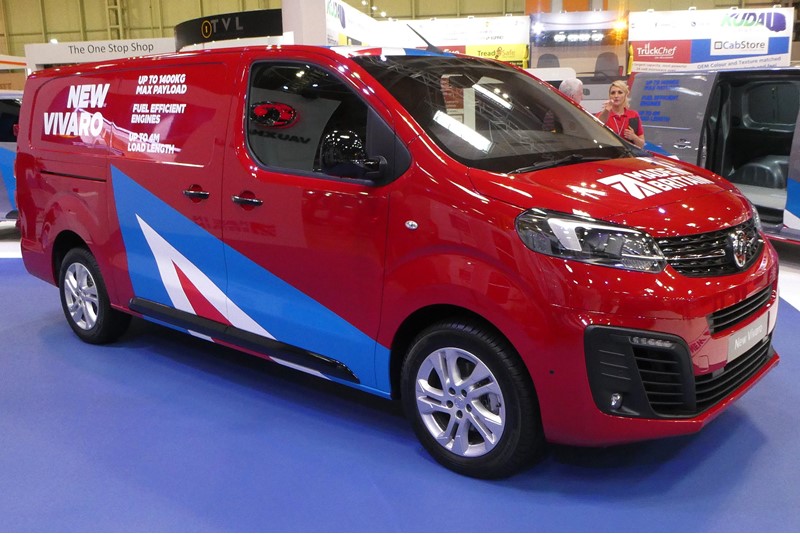
The new Vauxhall Vivaro has more payload, greater load length and is more efficient than its closest rivals, according to UK managing director Steve Norman.
Payload of up to 1,457kg is 19% more than the outgoing model, while the new van can accommodate four-metre load lengths and tow 2.5 tonnes, up 25%. Cargo capacity is also up 25% despite its compact exterior proportions.
The Vivaro’s 100PS 1.5-litre diesel has “22% lower emissions than the equivalent Transit and 20% lower than the Volks-wagen Transporter”, Norman said. The engine is also 16% more efficient for CO2 emissions and fuel consumption on the new WLTP test cycle than the old model’s NEDC figure (44.8mpg), making it around 52mpg.
The Vivaro, built in Luton and available to order now with the first deliveries at the end of July, will be available in three trims, five body options and six powertrains. Pricing starts at £21,240.
A key selling point is the move from a commercial vehicle platform to the PSA Group’s EMP2 platform, giving the van more car-like ride and handling qualities. It also means the introduction of advanced safety systems, including adaptive cruise control, autonomous emergency braking and surround view vision.
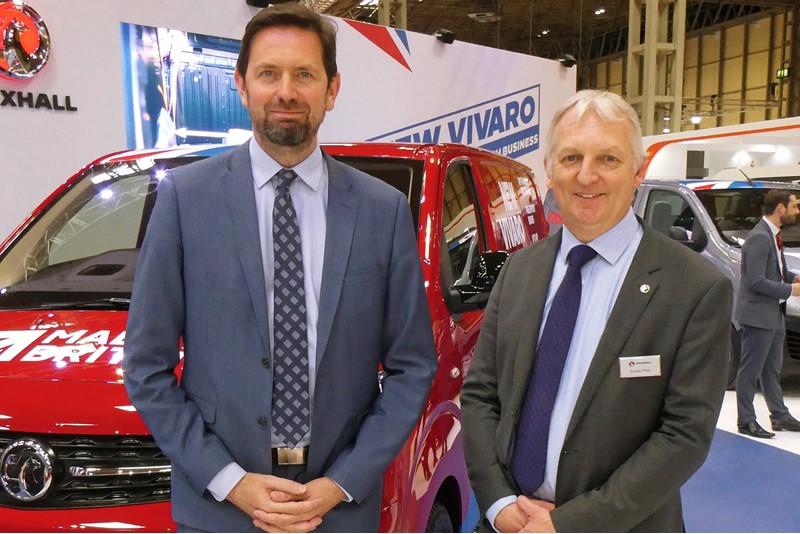
Vauxhall Commercial Vehicles brand manager Brad Miller (left in picture with LCV director Derek Wilson) also highlighted improvements in connectivity. “Vauxhall Connect will be standard,” he said. “Initially it will be eCall but it will be expanded in the next six-to-12 months to include navigation and Apple CarPlay. There will also be telematics.”
He added: “The new vans broaden our opportunities. Corporates were left out because we didn’t have the payload and towing capacity to meet their specific needs. Now we can.”
A full battery electric version (BEV) will be launched next year, but a plug-in hybrid will not be added.
“BEV is the way to go for a medium-sized van,” Miller said.
LDV: new EV30 debuts with £22,000 price tag
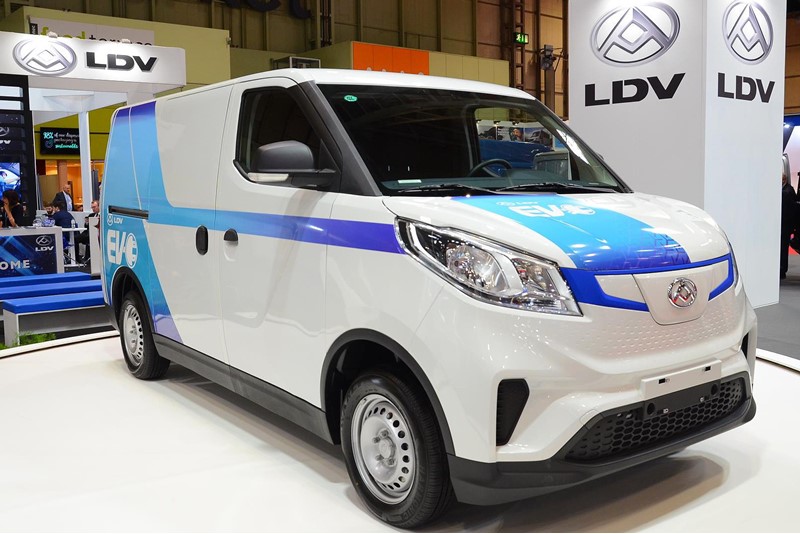
LDV managed to surprise CV Show visitors this year with the unexpected launch of the new EV30 compact electric van.
The show-stopping rival to the Nissan e-NV200 will be ready for deliveries next year and will be priced from just £22,000 (including the plug-in van grant).
Mark Barrett, general manager of LDV UK and Ireland, said: “With the EV30 pricing, we’re trying to work on building volume. It’s designed as an electric vehicle from the factory, which makes it cheaper to develop. We want to get into the Nissan pricing space.”
The EV30 is based on an all-new lightweight monocoque platform that uses an aluminium frame and lots of plastic components to maximise the payload.
Two sizes are available offering load spaces of five cubic metres and 6.3 cu m with payloads of up to one tonne.
Barrett said he has “no concerns” over availability of the new model, with the capacity to import 1,000 units per month.
“SAIC has recently started a joint venture with CATL, the third largest battery manufacturer in the world. Access to batteries is not an issue,” Barrett said.
Two battery options will be offered: 25kWh and 52kWh. The smaller one has a 120-mile range, while the larger can travel 200 miles.
Prices for the larger battery option have yet to be finalised.
“In 2020, we expect more than 50% of our sales to be electric vehicles,” Barrett said.
He added the EV80 will continue to be available as a 3.5-tonne van and chassis cab.
Also on the LDV stand was a facelifted version of the V80. It now features a Euro 6 diesel engine and as a new interior with a 10-inch infotainment screen.
PSA Group: electric Boxer/Relay to launch this year
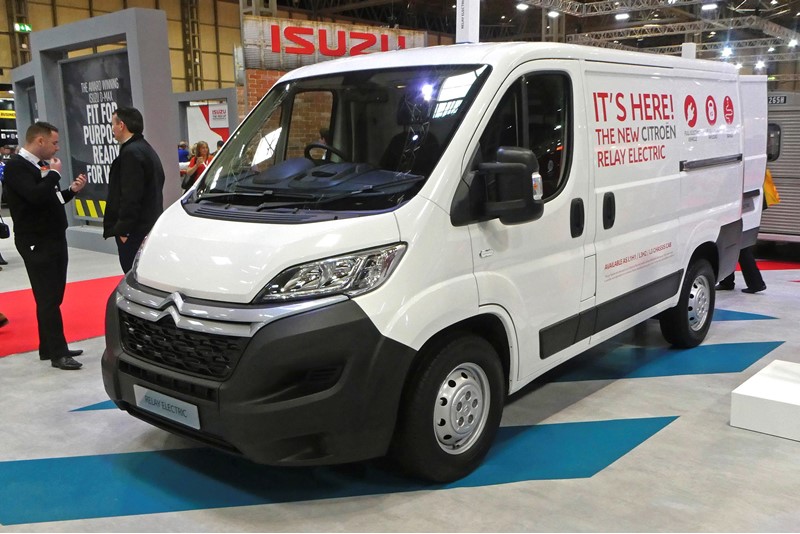
Peugeot and Citroën parent PSA Group has already announced its target of an electrified version of every model by 2024. Lifecycle planning would put the Boxer and Relay last in the queue, but customer demand has lifted both up the list of priorities, according to UK fleet director Martin Gurney.
The two models are going through homologation now, following conversions in partnership with BD Auto, and will go on sale in late Q3/early Q4.
“Because they are conversions, we can convert any version, for example chassis cabs,” said Gurney. “We expect L1H1 and L3H2 to be most popular because they are the most popular panel vans.”
Indicative range is 120-140 miles; the L3 will offer the greatest because it can accommodate a larger battery pack. PSA is using the highest gross vehicle weight payload so will be around 1,200-1,300kg, making the L3H2 version a four-tonne van.
Charging times on a Type 2 charger will be seven-to-eight hours; on rapid charge, it will drop to two hours. However, even on Type 2, 50% of the charge can be recovered within two hours.
Gurney anticipates interest “in the hundreds initially”, the majority of which will be from operators working in cities.
Pricing and specification will be revealed in autumn, but Gurney expects it to be competitive to challenge existing rivals in the market.
Peugeot and Citroën will launch a full-OEM production of the electric Dispatch and Expert in mid-2020, underlining PSA’s view that pure electric is the best option.
“Fleets that want an electric van want it for a specific purpose and a hybrid version doesn’t offer any benefit,” Gurney said.
“In addition, full BEV is more cost-effective to produce.”
Ford: Transit payload boosted by 80kg
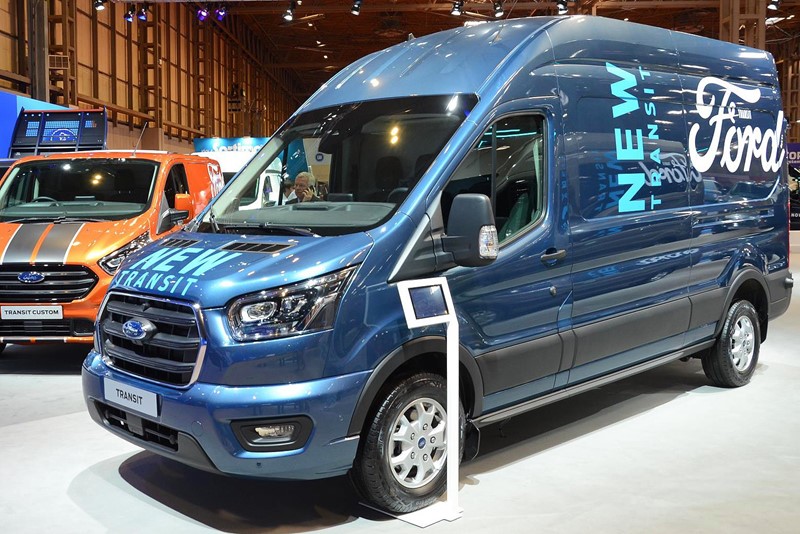
Ford has revealed that its new 2.0-tonne Transit will offer up to 80kg of additional payload when it goes on sale this summer.
Weight savings have been achieved thanks to the use of computer-aided design systems. They include an aluminium bonnet, composite bulkhead and ‘marginal gains’ by reducing the weight of many parts without affecting strength and durability.
Aligned to an upgraded 2.0-litre EcoBlue diesel line-up, the reduced weight makes the Transit up to 7% more fuel efficient, with CO2 emissions from 156g/km.
Ford is also introducing a more powerful 185PS variant and a 10-speed automatic transmission for rear-wheel drive models, while a 48-volt mild hybrid option cuts fuel consumption by another 8% in stop-start urban applications, with 144g/km CO2 emissions.
The Transit also gets a new interior, the Sync 3 communication and entertainment system, and additional safety technology, including intelligent adaptive cruise control, park assist, lane-keeping aid, pre-collision assist and blind spot information.
MAN TGE: new conversions a ‘perfect mate’ for closed bodies
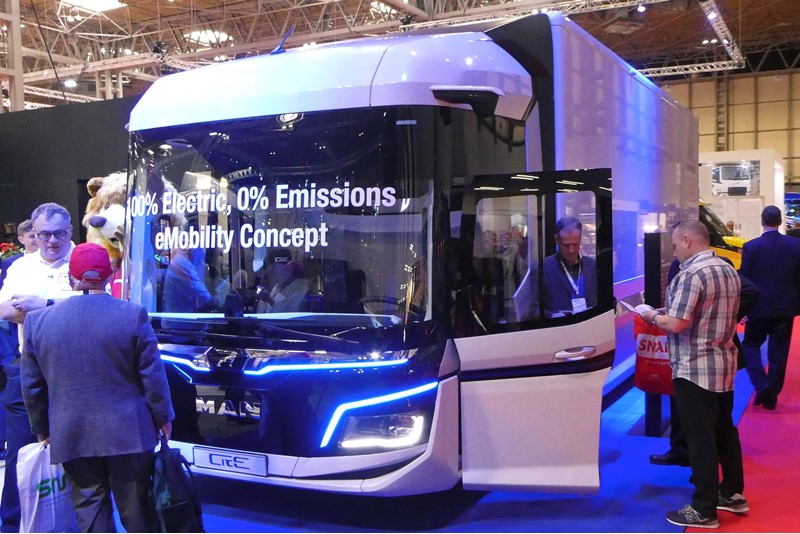
MAN Truck and Bus UK has revealed a range of new Vans to Go conversions based on its 3.5-tonne TGE panel van.
In addition to a new minibus, the company has launched a flat-frame chassis capable of accommodating boxes bodies and Lutons.
Described by MAN UK managing director Thomas Hemmerich as “a perfect mate for closed bodies”, the new chassis will enable MAN to “conquer a new market segment with the TGE”, he said.
Hemmerich added: “We have agreement with minibus converters and we hope to enter this interesting segment.”
He is also hopeful of getting a right-hand drive version of the electric TGE, based on the Volkswagen Crafter, by the end of next year and is close to signing two big orders that will justify the investment.
The electric TGE will have an eight-year battery warranty and from a cost of ownership point of view is a “no-brainer” in London’s ultra-low emission zone, according to Hemmerich.
It will be part of MAN’s eMobility range, which also includes the eTGM and a new CitE concept truck targeted at urban operators.
The CitE, first revealed at the IAA show last year, is powered by a 220kW battery offering a range of up to 60 miles. The cab features all-round visibility and a low floor with one-step access to the cab.
MAN has introduced two new pieces of technology, a driver’s app and a diagnostics black box.
The app allows pre-checks and includes the truck manual. The driver can scan parts of the truck to get instructions on usage. The black box, MAN Check, monitors vehicle health giving workshops and fleets access to data such as oil levels to reduce potential repair and maintenance downtime. It also alerts the driver if there is a technical fault.
Toyota: Proace City to target new sector
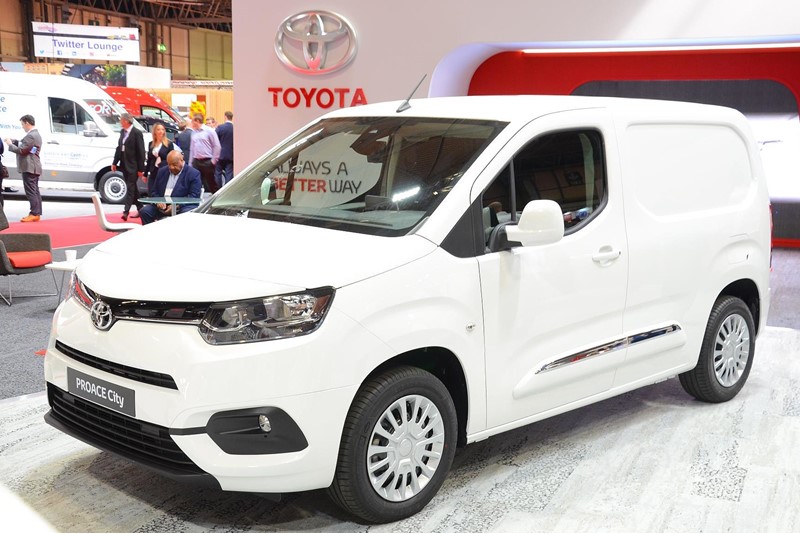
The new compact Proace City van will move Toyota into a new sector when it is launched next year.
Details are still to be confirmed, but it is likely to be available in two trims and two body lengths (short- and long-wheelbase) with Toyota’s five-year/100,000-mile warranty.
Both variants will be available with three front seats, while the LWB version also comes as a crew van with a second row of fold-flat seats as well as a panel van.
Payload is up to one tonne and towing capacity is 1.5 tonnes. Pricing will be announced later in the year but is likely to start in the region of £17,000.
Stuart Ferma, Toyota general manager, fleet operations, said: “We see it complementing the CV range we have been expanding over the past three years. It’s another addition to go into fleets with more options.”
Built to compete against the likes of the Ford Transit Connect and based on the same platform as the Citroën Berlingo, Peugeot Partner and Vauxhall Combo (but with the longer warranty), Toyota is pitching its smallest van at the SME market where the competition is less intense.
Lex: EV promotion scuppered by lack of vehicle supply
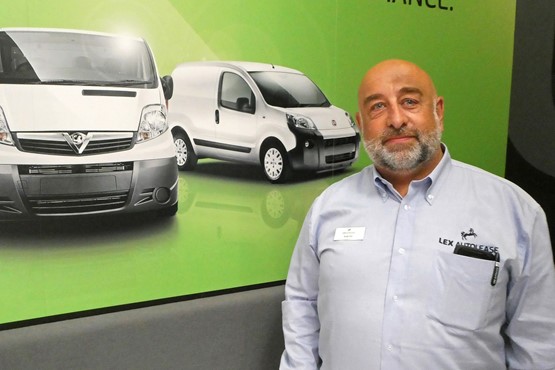
Lex Autolease was using the CV Show to promote its EV1000 offer, which aims to help businesses to transition into electric vehicles (EVs).
The first 1,000 customers to take EVs will get £1,000 back.
“It’s gaining momentum with some big corporate customers, but it’s not helped by the lack of availability of commercial EVs.
“At the moment, the big challenge, for us, is the manufacturers having product,” said Andy Hill (pictured), Lex’s commercial vehicle manager.
The introduction of WLTP regulation for the commercial vehicle sector in September is also causing supply issues, Hill said.
“We are seeing some problems at the moment. There are a lot of vehicles that we aren’t able to quote on. I believe that will wash through.”
Smaller vans are becoming more popular as operators look to downsize the vehicles on their fleets.
“Streets are more congested so the smaller vehicle, the better. A lot of drivers take vans home at night and parking can be an issue. We saw them go from 7.5-tonne to 3.5-tonne and they seem to be carrying on that trend,” Hill said.
Lex Autolease provides its customers with free access to a team of CV engineers who are able to discuss the right vehicle to suit a specific need. This can include full project management of a vehicle from initial enquiry to handover.
VisionTrack: connected cameras give operators a bigger picture
A growing number of fleets have recognised the importance of having complete visibility and control through video telematics to better protect drivers, other road users and their reputations, according to Simon Marsh, managing director of VisionTrack.
He says commercial fleets are increasingly turning to connected mobile digital video recorders to improve road safety and reduce insurance cost by combating fraud, controlling the claims process and better understanding fleet risk.
“Connected camera technology has achieved significant traction within the road transport sector in recent years and we are now seeing commercial fleets using the knowledge they have gained to push the boundaries of video telematics,” explains Marsh.
At the show, the company was highlighting how its ADAS solutions can combine a forward-facing camera, in-vehicle fatigue and distraction monitor, and driver feedback device to detect and warn of driver risk.
The camera identifies lane departure, forward collisions, tailgating and vulnerable pedestrians or cyclists, while the in-vehicle monitor can recognise if a driver is tired or distracted.
As a result, the driver can be immediately alerted, while a fleet manager can monitor areas of concern both in real-time and historically.
Cartwright: legislation drives development of more efficient trailers
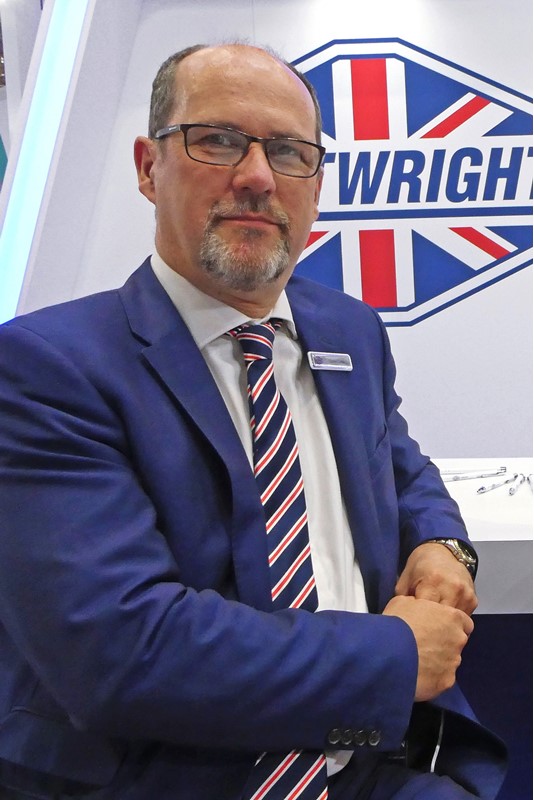
Urban delivery solutions are one of the many innovations that Cartwright is working on to reduce emissions from commercial vehicles.
Weight and aerodynamics are key considerations for the company’s latest range of conversions and trailers, as new legislation pressures the commercial vehicle industry to become cleaner.
Lionel Curtis (pictured), technical director at Cartwright, says: “We’ve done a lot of stuff for the urban market. There are lots of light conversions on chassis cabs but build quality is important. There is much to be said for lightweighting but you have to do it carefully using high quality materials.”
He believes operators need to be ready to change their mind-set and embrace new technologies and solutions to reduce their carbon footprint.
A new 4,650mm double-deck trailer, designed for the Irish market in order to meet height restrictions, borrows technology from the aircraft and construction industries. It has a 40mm thick deck, providing two 1,830mm levels.
The new trailer can carry 44 pallets and offers a 4% reduction in fuel consumption.
Refrigerated trailers will also be affected by new legislation to reduce emissions.
Curtis said this will require new electric refrigeration units that are powered independently from the tractor unit.
Also on stand was a new 3.5-tonne box van conversion, designed for the parcel delivery industry. It has a low entry height and a slam lock feature on the rear doors.
SMMT: report stresses importance of vans to the economy
The UK’s dependence on vans was highlighted by the Society of Motor Manufacturers and Traders (SMMT) in a new report that launched at the CV Show.
It revealed that there are more than 4.6 million vans on the road and 3.4 million people use or rely on a van for their work, delivering a combined wage bill of more than £56 billion per year.
Mike Hawes, SMMT chief executive, said: “With a lot of the issues that we are dealing with, people don’t give due consideration to the CV sector, so we wanted to do something that informed them of the dependence of society on commercial vehicles.”
There has been a 50% surge in the number of vans on British roads since 2009 and more than 900,000 used vans change hands every year.
The construction industry alone is responsible for a quarter (one million) vans on UK roads.
“There is a shift in logistics with some downsizing from trucks going on. The biggest segment is large vans, which is growing at the fastest rate,” explained Hawes.
Online shopping has also contributed to the boom in van demand, with 83% of consumers now expecting home delivery.
While manufacturers are investing heavily to develop ultra-low and zero emission vans demand for them remains low, accounting for just 0.3% of the market in 2018. To increase uptake, Hawes said a number of barriers must be removed, including tackling range and payload anxiety and addressing the sector’s specific charging needs
“The potential future demand for batteries in the short to medium term runs into millions and we don’t produce any in the UK,” he added.
Geotab: EV audits give foothold in the UK
Relative telematics newcomer Geotab has only been in the Europe for the past five years, but has a long history in its home North American market.
In the UK, the company focuses on two core solutions: telematics for the light commercial/truck sector, including monitoring driver behaviour, vehicle operation and remote downloads for digital tachographs to prevent infractions; and, assisting fleets with the move to electrification through a consultation service. The latter is helping to company boost its profile with fleets.
“We offer a sustainability assessment to identify the vehicles that could switch to electric, based on the type of work and the driver,” said Stefano Peduzzi, Geotab director, Europe. “We recommend the vehicles and the models that fit the business so customers can make a conscious decision.”
A typical audit will look at the level of investment and total cost of ownership modelling versus diesel, and the operational elements, such as charging infrastructure, driver understanding and balancing demand.
Next year, Geotab will introduce a smart changing solution that enables fleets to directly manage their usage patterns.
Its van-targeted telematics solution connects to the on-board diagnostics (OBD), giving access to engine faults, fuel consumption, dash lights and driving style.
For cars, the company promotes its driver privacy feature. Status can be set manually, or switch automatically at the start of a shift or when the vehicle enters a certain area.
“We see reluctance , but we position ourselves as a tool that supports the drivers,” Peduzzi said. “GPS/location can be less important. Of the data we collect, only one third is location; two-thirds are vehicle-related.”
Geotab’s technology also links into big data to provide information at a granular level, such as weather conditions, which can be relayed to the sat-nav data. It could also extend to monitoring air quality levels on the street to provide data at different times of the day, benefiting the whole community.



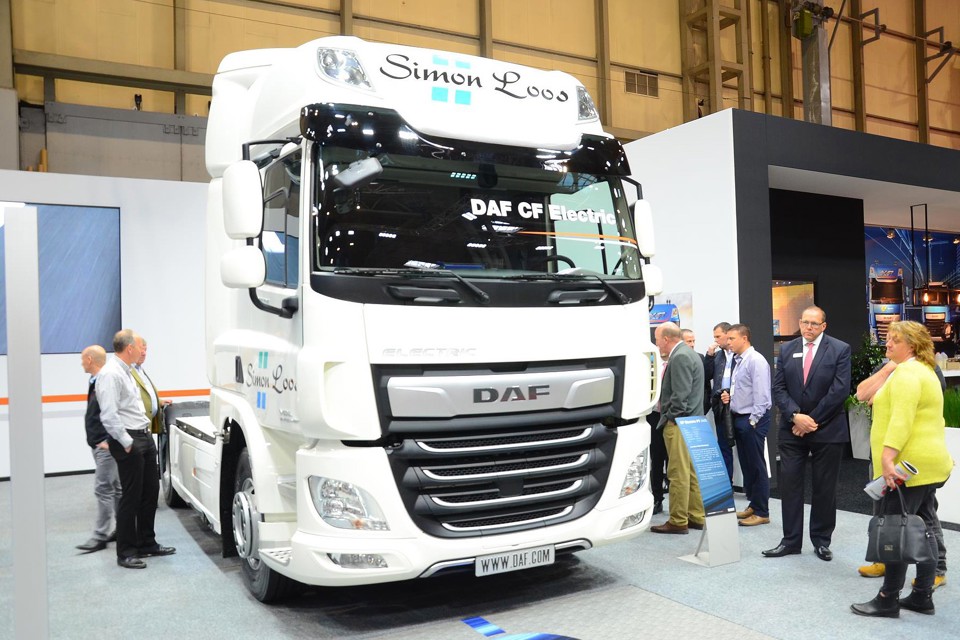
















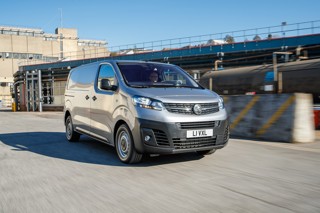
Login to comment
Comments
No comments have been made yet.